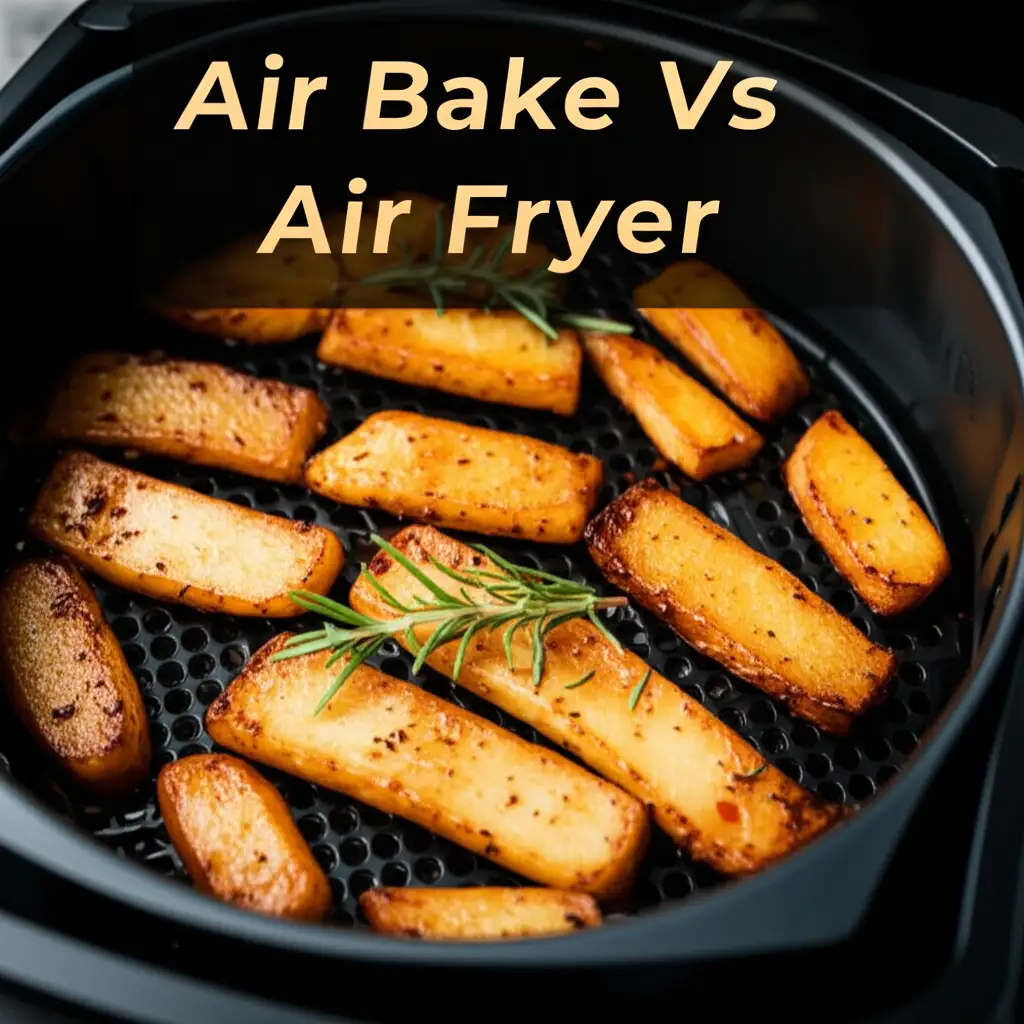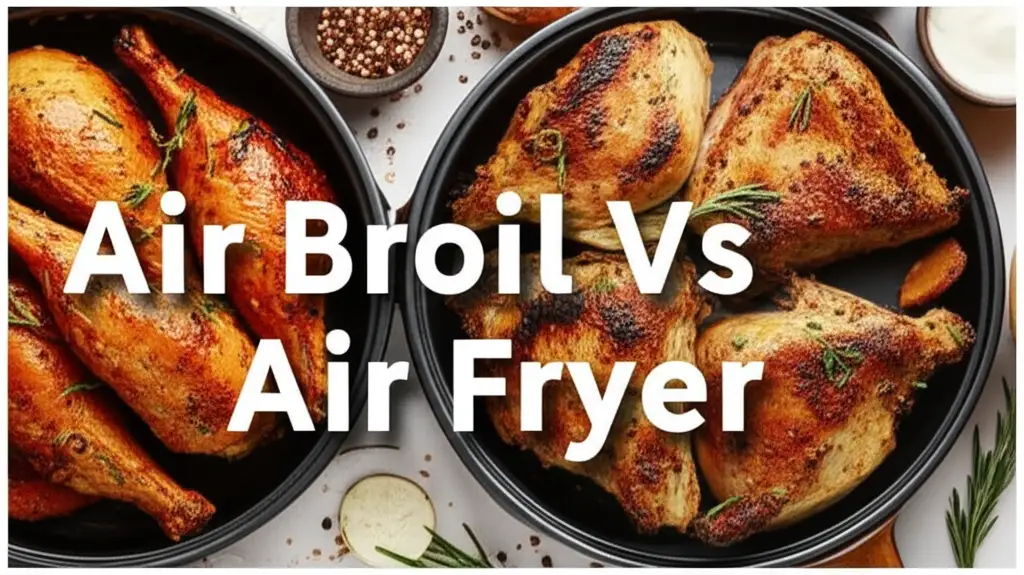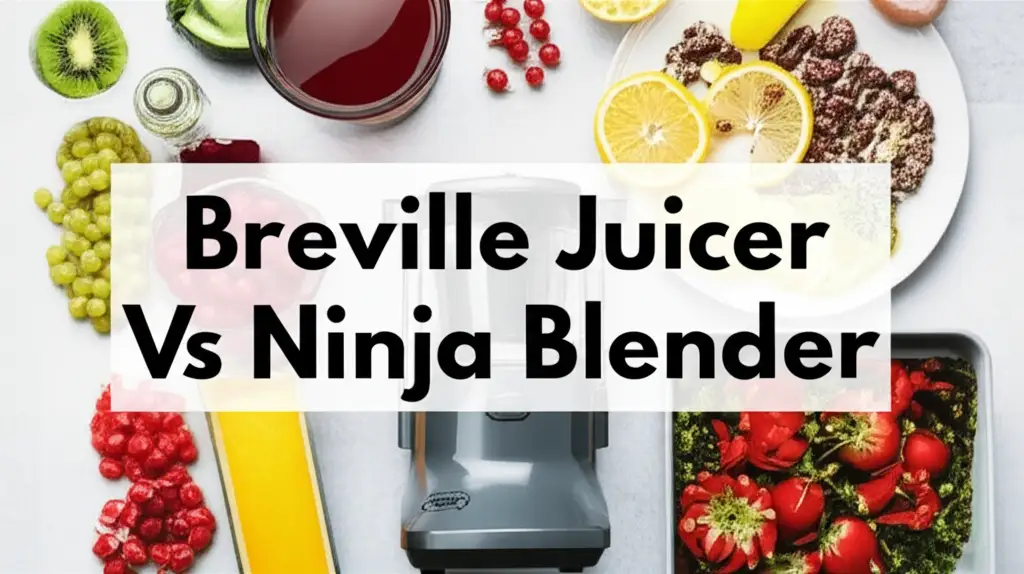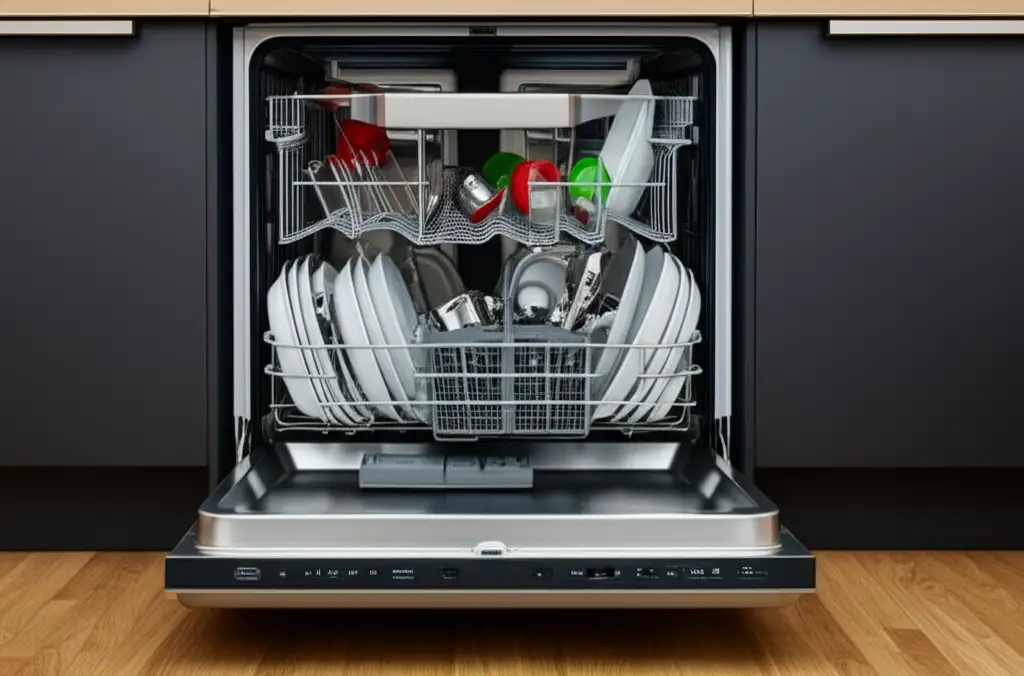· Elira Thomsen · Kitchen Appliances · 14 min read
Air Bake Vs Air Fryer

Air Bake vs. Air Fryer: Understanding the Difference for Crispy Results
Many of us want crispy, delicious food without a lot of oil. We see “air fry” and “air bake” settings on kitchen appliances. It can be confusing to know what each one does. Today, we will break down the differences between air bake vs air fryer functionalities.
This article explores how these cooking methods work. We will examine their unique benefits and ideal uses. You will learn which appliance best suits your cooking style. I will also share tips for getting the best results from your kitchen tools.
Takeaway
- Air fryers use intense, focused hot air circulation for ultra-crispy, fried-like textures. They are ideal for smaller batches and quick cooking.
- Air bake refers to convection baking, using circulating hot air for even cooking. This method is great for larger items like roasts, baked goods, and casseroles.
- Main difference: Air fryers circulate air faster and at a higher intensity than typical convection (air bake) settings. This creates a more significant “frying” effect.
- Consider your needs: Choose based on preferred food types, cooking volume, and desired textures. Many modern ovens now combine both capabilities.
Concise Answer
Air bake uses convection heat, circulating hot air for even cooking and browning, like a traditional oven with a fan. An air fryer is a compact, high-powered convection oven that circulates air much faster and more intensely, creating a crispier, “fried” texture with little oil.
What is Air Frying? Understanding the Core Technology
Air frying has become very popular. It offers a way to enjoy foods like fries and chicken wings with less fat. An air fryer creates a “fried” texture. It does this without submerging food in oil. This cooking method relies on powerful hot air.
I find my air fryer is perfect for quick meals. It heats up fast. Foods become golden and crunchy.
How Air Fryers Work
An air fryer is a compact countertop appliance. It has a heating element and a strong fan. The fan circulates hot air around the food at high speed. This hot air hits all surfaces of the food. It creates a powerful convection effect.
This process cooks food evenly. It also promotes the Maillard reaction. This reaction gives food its appealing brown color and crispy texture. A small amount of oil, or even none, is often enough.
Benefits of Air Frying
Air frying offers many benefits. It reduces the need for large amounts of cooking oil. This means your meals can be healthier. The high heat and fast air circulation cook food quickly. This saves time in the kitchen.
Air fryers are also easy to clean. Most models have non-stick baskets. You can often put parts in the dishwasher, making cleanup simple. Knowing if my air fryer is dishwasher safe makes maintenance even easier.
Common Air Fried Foods
Air fryers excel at making certain foods incredibly good. French fries, chicken nuggets, and frozen appetizers turn out wonderfully crispy. They are also great for reheating leftovers. Pizza slices and spring rolls become crunchy again.
I often use my air fryer for vegetables too. Brussels sprouts or broccoli get a nice char and tender inside. You can even roast small cuts of meat or fish. Just remember to shake the basket for even cooking.
What is Air Baking? Exploring the Convection Oven Concept
When people talk about “air baking,” they usually refer to cooking with a convection oven. A convection oven has a fan. This fan circulates hot air throughout the oven cavity. This is different from a traditional oven.
A traditional oven uses static heat. Convection ovens distribute heat more evenly. I have always found my convection oven bakes beautifully. It ensures everything browns perfectly.
How Air Baking Works in a Convection Oven
A convection oven uses a fan to move hot air. The fan is usually at the back of the oven. It blows heated air over and around your food. This constant air movement helps food cook faster. It also promotes even browning on all sides.
The fan also removes moisture from the oven’s air. This removal of moisture helps create a crispier exterior on certain foods. It is a gentler air flow compared to an air fryer. Many recipes suggest lowering the temperature slightly when using convection.
Advantages of Air Baking
Air baking, or convection baking, offers several advantages. Food cooks more evenly. You avoid hot spots that can burn parts of your dish. This is especially good for baking multiple trays of cookies.
Convection helps food cook faster. This can save you time and energy. You can cook larger items like roasts or whole chickens. It provides a consistent environment for baking. For example, learning how to bake in a Wolf oven often involves using its convection feature.
Best Foods for Air Baking
Air baking is excellent for many types of food. It is perfect for roasted vegetables. Potatoes, carrots, and asparagus get a lovely caramelization. Baked goods like cookies, pies, and cakes benefit from even heat.
Meat dishes, such as roasted chicken or pork tenderloin, cook uniformly. They develop a delicious crispy skin. You can even bake bread in a convection oven. I often bake bread, and a convection setting can give a great crust. Knowing if you can bake bread in a convection toaster oven opens up more possibilities.
Key Differences: Air Bake Vs Air Fryer - Heat, Speed, and Texture
Understanding the core distinction between air bake and air fryer functions is important. While both use circulating hot air, their intensity and purpose differ. It is like comparing a strong breeze to a gentle gust. Each serves a specific cooking goal.
I always think of air fryers as highly specialized mini-ovens. Air bake is simply an enhanced oven feature.
Air Circulation and Heat Intensity
The biggest difference lies in air circulation. Air fryers have a powerful fan. This fan circulates air very quickly within a small space. This creates an intense, concentrated hot airflow. It hits the food from all directions.
Convection ovens, or “air bake” settings, use a fan too. However, the airflow is less forceful. It is designed to ensure even heat distribution across a larger oven cavity. This prevents hot spots and promotes uniform cooking, but without the extreme crisping power of an air fryer.
Cooking Time and Energy Use
Due to the intense air circulation, air fryers cook food much faster. They also preheat more quickly. This makes them highly energy-efficient for small batches. You do not need to heat a large oven.
Convection ovens also cook faster than conventional ovens. But the speed increase is less dramatic than with an air fryer. They are more energy-efficient than traditional ovens for larger tasks. For small meals, an air fryer usually wins on speed and immediate energy savings.
Achieving Desired Food Texture
The texture of the food cooked in each appliance varies. Air fryers create a very crispy, almost deep-fried texture. The high-speed air rapidly dehydrates the food’s surface. This forms a crunchy crust.
Air baking, or convection, provides even browning and a slightly crispier exterior than conventional baking. It is excellent for uniformly cooked baked goods or roasted meats with a nice skin. It will not achieve the same extreme crispiness as an air fryer.
Appliance Design and Kitchen Space Considerations
When choosing between an air fryer and an oven with an air bake function, size matters. Air fryers are typically countertop appliances. They come in various sizes. Ovens with convection features are larger.
My kitchen space definitely influences my appliance choices. I consider both function and footprint.
Compact Air Fryer Models
Air fryers are generally compact. They fit easily on most kitchen counters. You can find small basket models for single servings. Larger basket or oven-style air fryers can cook for a family. Their small size means they heat up quickly.
This compact design makes them great for small apartments. They are also good for dorm rooms or anyone with limited kitchen space. They offer a specific cooking function efficiently.
Versatile Convection Ovens and Range Features
Many modern ovens, both wall ovens and ranges, include a convection or “air bake” setting. These appliances offer much more cooking versatility. You can roast, bake, broil, and use the convection feature. They handle large casseroles, sheet pans of vegetables, and big roasts.
These ovens are built into your kitchen. They do not take up extra counter space. If you need a full oven for diverse cooking tasks, a convection oven is a complete solution. It offers the “air bake” function as part of a larger package.
Ideal for Small or Large Kitchens
For small kitchens, a dedicated air fryer often makes sense. It offers a powerful specific function. It does not require a full oven upgrade. It is a good choice for quick meals and crispy snacks.
In larger kitchens, or for those who cook big meals often, an oven with an “air bake” convection feature is more practical. It provides broad capabilities. You can cook multiple dishes at once. It combines various cooking methods in one appliance.
Versatility and Food Compatibility: Beyond Frying and Baking
Both air fryers and convection ovens are versatile. However, their primary strengths differ. An air fryer excels at specific tasks. A convection oven has a wider range of uses. Understanding this helps you pick the right tool for your meal ideas.
I like to think about what I cook most often. This guides my appliance choices.
Air Fryer’s Diverse Capabilities
Air fryers are fantastic for achieving crispiness. They are not just for “frying” food. You can use an air fryer to roast small vegetables. It is great for reheating leftovers, making them crispy again. Some models can even dehydrate fruits.
Many people use them to bake small items like cookies or muffins. They perform well for frozen foods, turning them into a quick meal. The limited space inside means you often cook in batches. This works well for single servings or small families.
Convection Oven’s Broader Culinary Scope
Convection ovens (with “air bake”) offer a broader range of culinary uses. They are suitable for large roasts, baking multiple trays of cookies, or cooking entire casseroles. The fan ensures even heat distribution across the whole oven cavity. This is ideal for larger-scale baking and roasting.
You can also use a convection oven for conventional baking. This flexibility makes it a central kitchen appliance. It can handle almost any dish a standard oven handles. Plus, it offers the benefit of faster and more even cooking.
What Foods Cook Best in Each
Certain foods truly shine in each appliance. For quick, super-crispy items, the air fryer is king. Think of chicken wings, frozen fries, or crispy tofu. It mimics deep-frying texture with less oil.
For larger items, delicate baked goods, or anything needing uniform cooking across a big surface, the convection oven is better. Examples include roasted turkeys, layer cakes, or multiple sheets of roasted vegetables. The “air bake” setting provides a consistent heat environment.
Energy Efficiency and Operational Costs
When buying kitchen appliances, energy use is a key factor. Both air fryers and convection ovens aim to be more efficient than traditional ovens. They heat food faster and more directly. However, their energy consumption patterns differ based on their design and typical usage.
I always consider the long-term running costs of any new appliance.
Comparing Power Consumption
Air fryers typically use less power than a full-sized oven. They are smaller. They only heat a small chamber. This means they consume fewer watts per hour when running. This makes them energy-efficient for small cooking tasks.
Convection ovens, being full-sized ovens, draw more power overall. However, they are more efficient than conventional ovens. The fan helps them reach temperature faster and cook food more quickly. This reduces the total time they need to be on.
Faster Cooking, Lower Energy Bills?
Yes, faster cooking usually means lower energy bills. An air fryer’s rapid cooking time translates to less electricity used per meal. For small portions or quick snacks, it is a clear winner in energy efficiency. You avoid heating a large oven for a small task.
Convection ovens also cook faster than standard ovens. If you are roasting a large chicken, using convection can save 15-20 minutes. This cumulative time saving adds up over time. It can lead to lower energy bills for larger cooking projects compared to a non-convection oven.
Long-Term Savings
Over time, using the right appliance for the right task brings savings. If you frequently cook small, crispy items, a dedicated air fryer can save money. It uses less power for those specific tasks.
If you often cook large meals or bake frequently, a convection oven is more efficient. It handles bigger loads efficiently. Many modern ovens combine both convection and air fry modes. This offers maximum versatility and efficiency in one appliance. This combines the best of both worlds for diverse cooking needs.
Cleaning and Maintenance: Keeping Your Appliances Pristine
Keeping your kitchen appliances clean is important. It ensures they work well and last longer. Both air fryers and convection ovens need regular cleaning. However, the cleaning process for each differs due to their design.
I find that routine cleaning makes a big difference. It prevents stubborn messes.
Air Fryer Cleaning Tips
Cleaning an air fryer is generally simple. Most models have removable baskets and trays. These parts often have a non-stick coating. You can usually wash them with warm, soapy water. Some parts might even be dishwasher safe. It is helpful to know if your air fryer is dishwasher safe to make cleaning even easier.
For the main unit, wipe it down with a damp cloth. Make sure it is unplugged first. Avoid abrasive cleaners. These can damage the non-stick surfaces. Regularly cleaning your air fryer helps maintain its performance. It also keeps your food tasting fresh.
Convection Oven Cleaning Routines
Convection ovens are part of a larger appliance. Cleaning them involves cleaning the entire oven cavity. Many modern ovens have self-cleaning functions. These use high heat to burn away food residue. This makes cleaning much easier.
For regular spills, wipe them up quickly. Use an oven cleaner for tougher messes if your oven does not have a self-cleaning feature. Always follow the manufacturer’s instructions. A clean oven ensures even heat distribution for your “air bake” functions. Regularly cleaning oven components contributes to its overall efficiency.
FAQ Section
Can I use an air fryer to bake cakes?
Yes, you can bake small cakes or muffins in an air fryer. The intense, circulating hot air cooks them quickly. You may need to adjust cooking times and temperatures. Always use smaller baking pans that fit well inside the air fryer basket.
Is air baking healthier than air frying?
Both air baking (convection) and air frying are healthier than deep-frying. Air frying usually uses less oil than deep-frying, focusing on a crispy texture. Air baking is just a more efficient way to use an oven, generally for larger items, still offering healthy cooking options.
Do air fryers make food crispy like deep frying?
Air fryers get food very crispy, similar to deep frying, but with much less oil. The rapid hot air circulation creates a crunchy exterior. It is not exactly the same as oil immersion, but it provides a very close texture without the excess fat.
What’s the main difference in heat distribution?
The main difference is the intensity and speed of air movement. Air fryers have a very powerful fan moving air intensely in a small space for maximum crisping. Convection ovens (air bake) use a gentler fan to ensure even heat across a larger cavity, preventing hot spots and cooking uniformly.
Can an air fryer replace a convection oven?
An air fryer cannot fully replace a convection oven. An air fryer is best for smaller, crispy items. A convection oven is a full-sized appliance. It handles large roasts, multiple trays of cookies, and diverse baking needs. Some modern ovens now include a dedicated “air fry” mode.
Is “air bake” just another name for convection baking?
Yes, “air bake” is essentially another term for convection baking. It indicates that the oven uses a fan to circulate hot air. This differs from a conventional oven that uses static heat. It enhances even cooking and browning.
Conclusion
Understanding “air bake vs air fryer” clarifies important differences in kitchen appliances. An air fryer offers intense, rapid hot air circulation. It specializes in making small, crispy foods with little oil. It is ideal for quick snacks and smaller meals. I find it incredibly efficient for many daily tasks.
On the other hand, “air bake” refers to the convection function in a larger oven. This feature provides even heat distribution. It cooks food uniformly across a bigger space. It is perfect for baking, roasting large items, and cooking multiple dishes at once. Many newer ovens combine both “air fry” and “air bake” capabilities. This offers the best of both worlds.
Ultimately, your choice depends on your cooking habits and kitchen space. Consider what foods you cook most often. Think about the amount of food you usually prepare. Whether you opt for a dedicated air fryer or a versatile convection oven, both tools enhance your cooking. They bring efficiency and delicious results to your home kitchen. Pick the one that fits your cooking style best!





